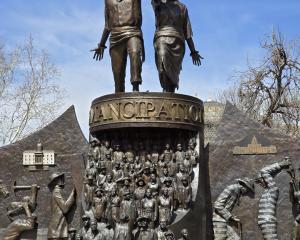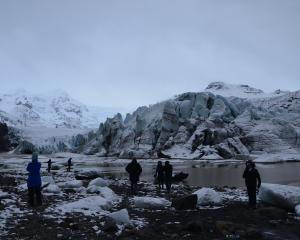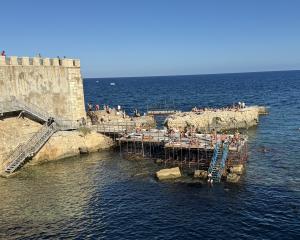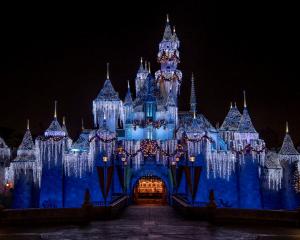Having travelled to the middle of nowhere, Blake Gopnik, is struck by the many possibilities presented by a work of art.
Only six people are allowed to see it every day, and only for six months of the year.
It's hours from the nearest city.
Photos are not allowed, so it barely even circulates in pictures.
There's even a tiny chance that, if you don't follow instructions, it could help you wind up dead.
And yet, for many of the few who've made the pilgrimage, it turns out to be "one of the great works of art of the last century".
That was the judgement of one art-historian friend, not usually prone to hyperbole, when he returned from a summer visit to The Lightning Field, a huge work of "land art" hidden in the middle of New Mexico.
His rave determined me to go.
A classic patch of sagebrush-covered land, set on an empty plateau 2195m high.
A ring of jagged mountains at its edges, out-clicheing any Hollywood Western.
And in the middle, 400 lightning rods, custom-made from stainless steel and laid out in a grid that stretches a mile in one direction and a kilometre in the other.
Set 67mapart, the rods tower to several times the height of a tall man; whatever kind of mound or furrow they get planted in, their tops all reach to the same table-flat height.
The work was built in 1977 by a New Yorker named Walter de Maria (then 42), who got his patrons at the Dia Art Foundation to buy the land and commission its conversion into art.
De Maria and his work are famous in the art world.
What seems strange, once you've visited his masterwork, is how they could be so little-known outside of it.
Lightning Field kept me looking and thinking for longer than I've spent with any other work of art, at least all in one stretch.
I wandered the site nonstop from afternoon to night of one long summer's day, and then from before dawn to almost noon the next.
I got lucky.
There were evening thunderstorms the first day I went, and the mountains all around were bright with lightning, although no strikes hit the rods while I was looking - you're not supposed to be out among them, anyway, when a storm's right overhead.
(De Maria chose the area partly for its electrical storms, which occur on something like 60 days annually.)The piece looks great by storm light, when it's likely to give as many goose bumps as the Sistine ceiling.
But the best thing about Lightning Field is that it seems to work at least as well by any other kind of light, at almost any moment you come across it.
There is no single Lightning Field - that name's the one false note in the whole piece.
Every time you look at it, this work feels new and acquires meanings you hadn't thought of earlier.
Its central virtue may be that, unlike almost any other artwork you could name, it doesn't have a single central virtue.
It's good that Lightning Field provides so much to see, because getting to see it is a chore.
You'd better book months in advance if you want to visit on a day that fits your schedule. (The site is open daily from May until October.
Booking, which starts in March, is by mail only.)Your overnight visit will cost you $US250 ($NZ356) - nonrefundable - which can be paid only by check to Dia, which still owns and tends the work.
If that sounds like a lot of money, note that food and lodging are included and that a bad hotel in New York could cost you more than that.
From the Albuquerque, New Mexico airport, you have a three-hour drive ahead of you, south and west to the tiny town of Quemado (population 324), where you need to be by 2.30pm.
That's when Dia caretakers pile visitors - never more than six at a time, by order of the artist - into a muddy 4x4 for an hour's winding drive across rural roads.
Eventually, you're dropped off at the site's original homestead, a vintage log cabin that's even more John Wayne than the landscape around it.
You'll be driven out the next morning at 11am.
You drop your bags, walk out the back door, and you're in a work of art, as you've never been before.
Ideas pile up.
Thought 1: The long trip was necessary.
De Maria's piece is clearly about the West, so it's only right that there should be some kind of trek to get you to your destination.
That's why the log cabin also feels so right.
If you stand in the no man's land between the cabin and the field of rods, you can go from looking "back" at the homestead and the region's past, and "forward" to de Maria's version of its future.
Thought 2: The future seen in Lightning Field is truly "futuristic".
Look at the rods, with the landscape as backdrop, and you could swear they're a Hollywood special effect.
Those crisp poles, with their slick reflections, hard shadows and regular grid, are just the kind of thing most easily rendered in CGI; stand among them, and it feels as if you've been green-screened in.
Back in the 1970s, Lightning Field already predicted how the 21st century would construct a vision of future worlds still further off.
Thought 3: Or this could be absolutely now, anywhere that surveyors grid up open land for subdivisions.
Thought 4: Who said modern art killed classic beauty? The sun begins to set, God's clouds and de Maria's rods are lit deep pink, and the Romantic Sublime takes over.
Turner, eat your heart out.
Thought 5: Art doesn't get more minimal and rigorous than this.
With the sun behind a cloud, the rods become a neverending grid of identical grey lines.
For a moment, aesthetics disappear and there's no room for arty histrionics.
All that matters is the statement of a concept: a ground plane.
A line rising from it.
A space.
Another line.
Repeat.
Thoughts 6 to 99, and on: With its endlessly receding avenues of rods, Lightning Field is the latest riff on classic Renaissance perspective (try Googling "isocephaly").
Or, this is art that sets itself apart from anything that's ever been made.
Lightning Field is about framing the landscape, so you understand it better and differently.
Or, it's the classic man-made denial of nature, using geometry to cancel out irregularity.
Lightning Field is brutal, all about the threat of death and nature's heedless wrath.
Or, it's as humane as any masterpiece could be, out to fill whatever uses we can put it to.
It's clear the experience is about as great and powerful as anything could be, but does that alone make Lightning Field an absolutely crucial work of art?The very greatest works, such as the best pictures of Titian, Manet, Cezanne or Picasso, leave you puzzled, and even risk repelling you.
Just as you think you've "got" what they're about, you're left feeling that you've somehow missed the point, or that you're simply dumber than they are.
That's almost the opposite of what happens with Lightning Field: As you bounce from reading to reading, you feel each time that you've got the piece just right and all tied up, before you move on to the next instant of opposite but equal certitude.
This feels like what can happen when you're looking at nature.
A great sunset may trigger thoughts of everything from the vastness of the universe to the brevity of human life, but we don't really credit the sunset itself for the ideas and feelings we have.
We own sunsets, and deep inside we take credit for their inspiration.
Maybe that means the almost-natural experience of Lightning Field, however rare and wonderful it is, risks leaving us feeling too fine and wise for our own good. - Blake Gopnik.












